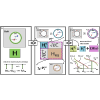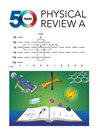Correspondence between quasiparticle dissipation and quantum information decay in open quantum systems
IF 2.9
2区 物理与天体物理
Q2 Physics and Astronomy
引用次数: 0
Abstract
Diagrammatic techniques simplify a weakly interacting many-body problem into an effective few-quasiparticle problem within a system of interest (SOI). If scattering events, mediated by a bath, between those quasiparticles can be approximated as density-density interactions, the bath behaves like an effective external potential. On the other hand, exchange interactions could entangle those quasiparticles and the bath, leading to an open quantum system that induces quantum decoherence and spectral broadening. We investigate the renormalized interaction between the SOI and the bath, employing a projection operator technique similar to the one used in the Nakajima-Zwanzig method. We find that the frequency variation of this renormalized interaction is analogous to the quasiparticle residue and provides a measure of the SOI-bath separability that serves as the lower bound of the SOI-bath entanglement entropy. In the weak-coupling regime and continuum limit, we demonstrate that the degree of SOI-bath separability corresponds to the quasiparticle spectral weight in the single-impurity Anderson model and find that the loss of quantum information to the continuum of the bath can be understood as a decay process where an initial single-impurity state escapes to a thermal bath. This work provides a direction for connecting energy dissipation in quasiparticles propagation to the loss of quantum information in open quantum systems.

开放量子系统中准粒子耗散与量子信息衰减之间的对应关系
图解技术可将弱相互作用多体问题简化为相关系统(SOI)内的有效少准粒子问题。如果这些准粒子之间由浴介导的散射事件可以近似为密度-密度相互作用,那么浴的行为就像一个有效的外部势能。另一方面,交换相互作用可能会缠结这些准粒子和浴槽,从而导致一个开放的量子系统,诱发量子退相干和光谱展宽。我们采用与中岛-茨万齐格(Nakajima-Zwanzig)方法类似的投影算子技术,研究了 SOI 与熔池之间的重正化相互作用。我们发现,这种重规范化相互作用的频率变化类似于准粒子残差,并提供了 SOI 与浴分离性的量度,可作为 SOI 与浴纠缠熵的下限。在弱耦合体系和连续极限中,我们证明了 SOI-浴分离度对应于单纯度安德森模型中的类粒子谱权,并发现量子信息在浴连续中的损失可以理解为初始单纯度态逃逸到热浴中的衰变过程。这项工作为将类粒子传播中的能量耗散与开放量子系统中的量子信息丢失联系起来提供了一个方向。
本文章由计算机程序翻译,如有差异,请以英文原文为准。
求助全文
约1分钟内获得全文
求助全文
来源期刊

Physical Review A
物理-光学
CiteScore
5.40
自引率
24.10%
发文量
0
审稿时长
2.2 months
期刊介绍:
Physical Review A (PRA) publishes important developments in the rapidly evolving areas of atomic, molecular, and optical (AMO) physics, quantum information, and related fundamental concepts.
PRA covers atomic, molecular, and optical physics, foundations of quantum mechanics, and quantum information, including:
-Fundamental concepts
-Quantum information
-Atomic and molecular structure and dynamics; high-precision measurement
-Atomic and molecular collisions and interactions
-Atomic and molecular processes in external fields, including interactions with strong fields and short pulses
-Matter waves and collective properties of cold atoms and molecules
-Quantum optics, physics of lasers, nonlinear optics, and classical optics
 求助内容:
求助内容: 应助结果提醒方式:
应助结果提醒方式:


